Categories
Left column house ads
Cooking Like Karen DeMasco
January 31, 2013 Restaurant/Bar News
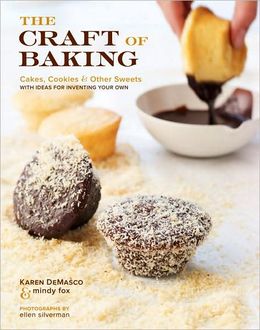 Last summer, I saw Karen DeMasco’s The Craft of Baking on my bookshelf, and I thought to myself: Cookbook post! The book may have been written when DeMasco was at Craft, but she’s at Locanda Verde now, so it qualifies. Plus, I had never cooked anything from it, and not for any good reason.
Last summer, I saw Karen DeMasco’s The Craft of Baking on my bookshelf, and I thought to myself: Cookbook post! The book may have been written when DeMasco was at Craft, but she’s at Locanda Verde now, so it qualifies. Plus, I had never cooked anything from it, and not for any good reason.
I took it out to the house we were renting in Litchfield, Conn., because I’m far more likely to bake there; in the city, I work from home, and any leftover food taunts me like the tell-tale heart.
RUSTIC CORNMEAL BLUEBERRY TART
Unfortunately, most of the summer went by without my baking anything from the book, which I attribute to the fact that the owners of the house had locked away their tabletop electric mixer (and I know they must have one because otherwise there’d be a handheld one or even a manual one).
Toward Labor Day, I got my act together and decided to bake the Rustic Cornmeal Blueberry Tart (click for recipe). For one thing, I’m drawn to desserts labeled “rustic” because it’s license for them to look a little sloppy, as if I have too much else on my plate—feeding the chickens or something—to bother with presentation. For another thing, the property had blueberry bushes, and DeMasco extols the virtues of wild blueberries in the recipe’s intro. Finally, a mixer was only needed to cream butter and sugar for the crust, which I knew I could do by hand.
The recipes for the cornmeal tart dough and the tart itself are very straightforward, except the dough recipe makes enough for two tarts and the tart recipe is for one tart. I halved the recipe for the dough, but I miscalculated the number of blueberries for the tart, ending up with too few (once I removed the ones I had picked from a blueberryesque bush—close call!). So I supplemented with blackberries.
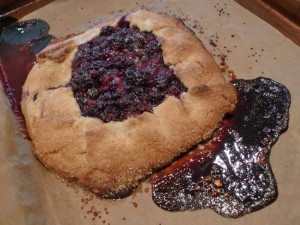 It’s more of a galette than a tart, with the edges folded over; my dough, alas, broke, and all the pinching and pressing in the world didn’t make it hold. Some juice leaked out as a result—it was sticky like candy, adhering to my teeth like glue but with great berry flavor—and yet the tart itself was juicy enough. (I know you think it looks like the dog’s dinner, but there’s no photo in the book to compare it to, so this might be how it’s supposed to look, and moreover, if you click that recipe link you’ll see that an esteemed food blogger’s version was pretty similar to mine.) I realized after the third bite that I had neglected to halve the salt in the dough recipe, and yet it didn’t exactly ruin the dessert. It just lended it an appealing edge; perhaps because we’re used to corn and salt together. Plus it gave me license to add more whipped cream—or should I say hand-whipped cream.
It’s more of a galette than a tart, with the edges folded over; my dough, alas, broke, and all the pinching and pressing in the world didn’t make it hold. Some juice leaked out as a result—it was sticky like candy, adhering to my teeth like glue but with great berry flavor—and yet the tart itself was juicy enough. (I know you think it looks like the dog’s dinner, but there’s no photo in the book to compare it to, so this might be how it’s supposed to look, and moreover, if you click that recipe link you’ll see that an esteemed food blogger’s version was pretty similar to mine.) I realized after the third bite that I had neglected to halve the salt in the dough recipe, and yet it didn’t exactly ruin the dessert. It just lended it an appealing edge; perhaps because we’re used to corn and salt together. Plus it gave me license to add more whipped cream—or should I say hand-whipped cream.
GINGERSNAPS
We started another Connecticut rental—this one in South Kent—in the fall, and again, no mixer! (Especially maddening because when we rented the same house four years ago, there was one.) So over the long Christmas weekend, I baked DeMasco’s Gingersnaps. (This blogger omitted DeMasco’s 1.5 teaspoons baking soda and used 3/4 cup Demerara sugar instead of 1/2 cup.) The Big Y supermarket didn’t have Demerara sugar, so I used Turbinado. And it didn’t have blackstrap molasses so I used regular. I suppose I should’ve tried harder on my sourcing, but they’re cookies—how much could either ingredient matter?
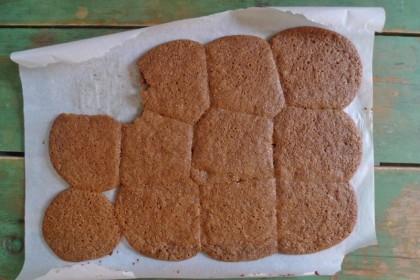 Besides, my main error was rolling the balls of dough too big. Consequently, the cookies didn’t have room to spread out. I don’t care about the aesthetics; they didn’t cook enough—by the time they were “dark golden brown” (whatever that means) on the outside, the insides weren’t ready. I know lots of people like an underbaked cookie, based on what I buy at bakeries, but it’s not for me. What I still don’t understand is how, if my balls—if my cookie balls—were more than 3/4″ in diameter, how did I end up with far more dough than I should have?
Besides, my main error was rolling the balls of dough too big. Consequently, the cookies didn’t have room to spread out. I don’t care about the aesthetics; they didn’t cook enough—by the time they were “dark golden brown” (whatever that means) on the outside, the insides weren’t ready. I know lots of people like an underbaked cookie, based on what I buy at bakeries, but it’s not for me. What I still don’t understand is how, if my balls—if my cookie balls—were more than 3/4″ in diameter, how did I end up with far more dough than I should have?
When desserts don’t work out the way you’d like them to, there’s only one thing to do: Break them into pieces and eat them with really good vanilla ice cream.
PINE NUT TART WITH ROSEMARY CREAM
If “rustic” lowers expectations, a recipe with a photo raises them. But for New Year’s weekend, we had to attempt the Pine Nut Tart with Rosemary Cream because it reminded us of a dessert we had had at our favorite non–New York City restaurant, Community Table in Washington, Conn. Last year, the dessert menu featured a pine nut tart with pine-needle ice cream, and it was amazing. To the best of my knowledge, the dish has never reappeared (the restaurant’s menu changes weekly).
The tart uses DeMasco’s Almond Sablé Dough, which you can make in advance and freeze for up to a month—which meant I was able to make it at home, using my tabletop mixer. The good news was tempered, however, by the way my mixer started leaking an oily brown fluid. (Apparently, I haven’t been using it enough.) I don’t think any of it got in the dough…. This recipe also makes enough for two crusts, so I left one in the freezer; I suppose I could’ve halved it if I wanted to deal with halving one egg and one egg yolk.
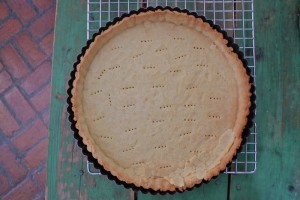 When it came time to make the tart, the dough rolled out beautifully—and I’m far from reliably adept at that—and I even got it into the pan in one piece. But this was my first time using a tart pan with a removable bottom, so after the tart had gone through its first 20 minutes of cooking, I removed it from the oven by holding it from the bottom, forcing a tear along the edge. I’m not too proud to admit that I located the leftover dough in the trash—it was still on top!—and made a patch, hoping we’d be able to tell which part not to eat.
When it came time to make the tart, the dough rolled out beautifully—and I’m far from reliably adept at that—and I even got it into the pan in one piece. But this was my first time using a tart pan with a removable bottom, so after the tart had gone through its first 20 minutes of cooking, I removed it from the oven by holding it from the bottom, forcing a tear along the edge. I’m not too proud to admit that I located the leftover dough in the trash—it was still on top!—and made a patch, hoping we’d be able to tell which part not to eat.
The making of the filling was a non-event, although a cup of firmly packed brown sugar and a cup of corn syrup made the tart pecan-pie sweet. We had decided not to deal with the rosemary cream because we had already spent much of the day cooking, and I bet the herbaceousness would cut some of the sweetness.
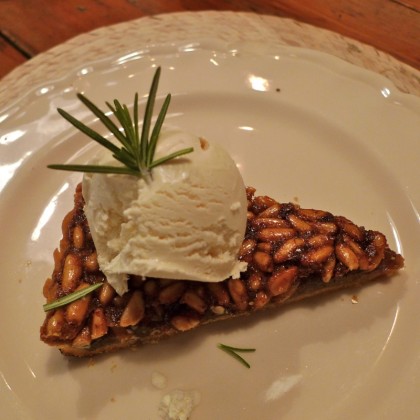 LEMON COCONUT BUTTERMILK TART
LEMON COCONUT BUTTERMILK TART
I still had one disk of frozen dough left. I was tempted to forget about it, but it really was the best part of the pine nut tart. The other recipes in The Craft of Baking that use the Almond Sablé Dough didn’t really speak to me—although Adam wanted me to make the Ricotta Cheese Tart—so I asked my friend Andrea, who suggested either Martha Stewart’s lemon, buttermilk, and coconut tart or Jean-Georges Vongerichten’s chocolate tart. I wasn’t in the mood to deal with chocolate, and I do like lemon, but a real coconut?! Andrea assured me that her version of the recipe, from a 1995 cookbook, calls for 1 cup plus 4 tablespoons shredded coconut.
One could argue that a Martha recipe has no business in this post, but DeMasco’s book is about honing one’s skills, and I wanted one more try at not screwing up the crust—the filling was beside the point.
I nailed it.
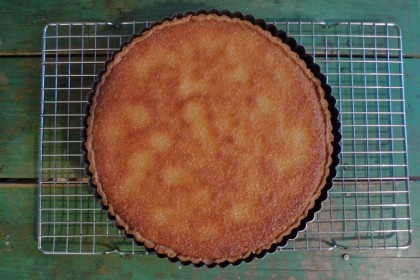 Previous “Cooking Like…” posts:
Previous “Cooking Like…” posts:
••• Cooking Like Nobu Matsuhisa
••• Cooking Like Aarón Sánchez
••• Cooking Like Kurt Gutenbrunner
••• Cooking Like Andrew Carmellini
4 Comments
Subscribe
Subscribe to the TC Newsletter







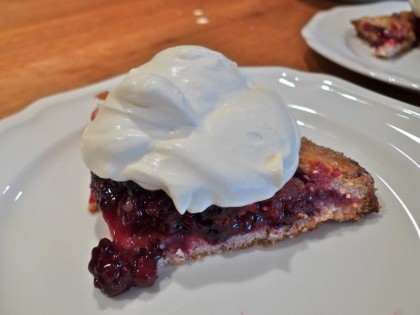






We use this book all the time. It’s fantastic! I love the jasmine rice pudding, the milk chocolate and hazelnut panna cotta, the banana malt ice cream, the brioche pain perdu… the list goes on and on. Her ice cream recipes are some the best, we’ve never had one come out badly. She’s a good teacher.
I just dropped off my mixer in Howard Beach—that was an exciting trip—and the repairman told me that the FDA insists the grease in mixers be edible!
Erik, if it’s any consolation to you, I just made a couple of batches of gougères (aka cream puff puffs with cheddar cheese in the dough) from a Dorie Greenspan recipe. Dorie is one of the best recipe writers around, yet I too got a way bigger yield than she predicted. And I followed the recipe to the letter. So don’t sweat the cookie yield. But next time (if there is a next time), just space them farther apart on the sheet. You might have to bake them in more batches; cool the sheet by running it under cold water before you place the next batch on it. Then again, you can set up succeeding batches on parchment paper and just slide the paper onto the sheet as soon as it’s cool enough.
There’s a video or other online instructions for cleaning and regreasing a KitchenAid mixer. But as far as I’m concerned, that’s only for real die-hard kitchen geeks. Not for me, probably not for you!
All your efforts look delicious — even the melted cookies, which are indeed the right color. But what did you do with all the rest of the buttermilk?
@Suzanne: I used it to coat the drain.